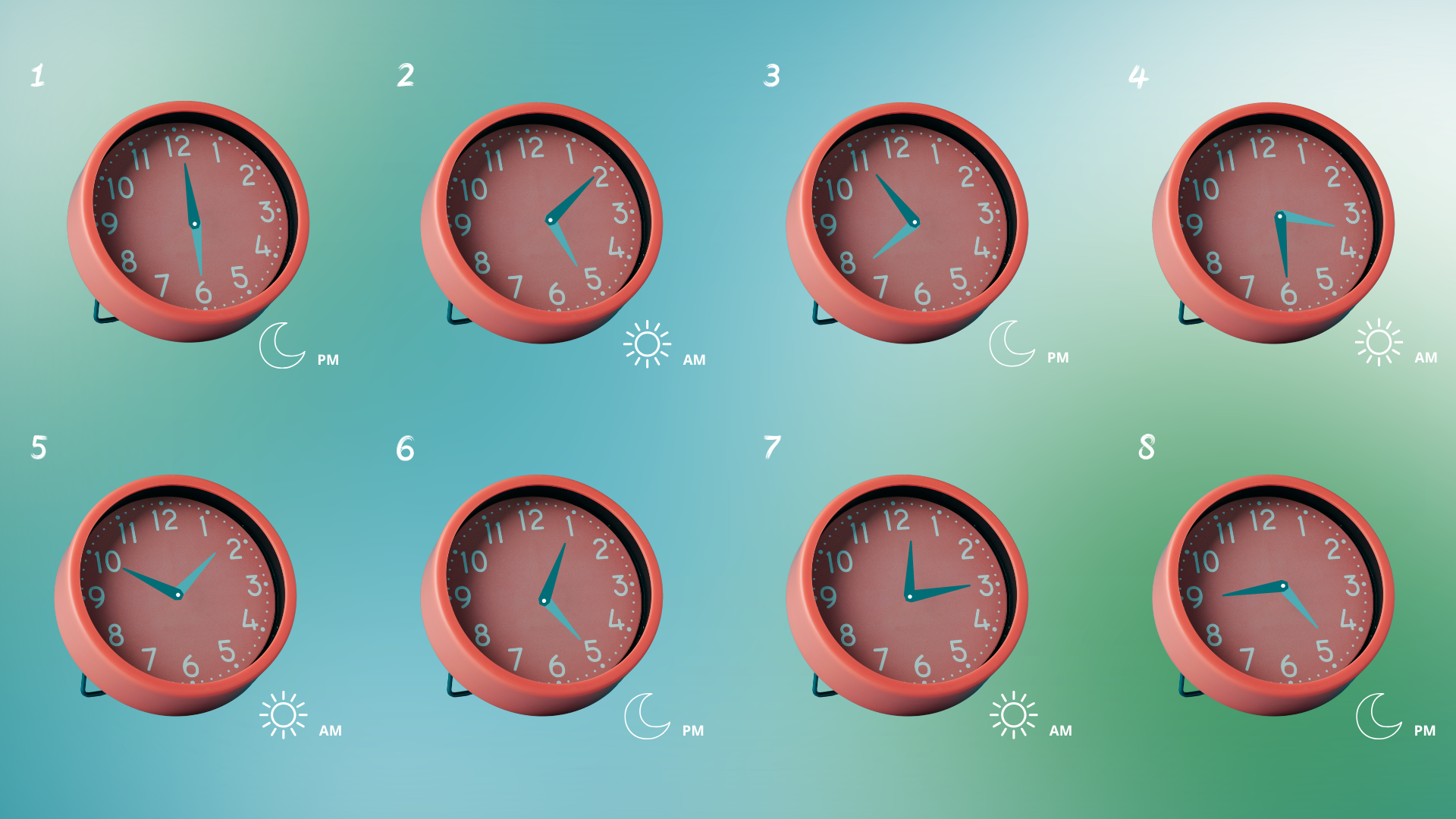This lesson covers telling time in Italian, focusing on expressions like "Che ora è?" and time phrases such as "le sette e mezza" (7:30) and "un quarto" (a quarter). Learn to read clocks and talk about moments like "del mattino" (in the morning) or "del pomeriggio" (in the afternoon).
Listening & reading materials
Practice vocabulary in context with real materials.
Vocabulary (17) Share Copied!
Exercises Share Copied!
These exercises can be done together during conversation lessons or as homework.
Exercise 1: Reorder sentences
Instruction: Make correct sentences and translate.
Exercise 2: Match a word
Instruction: Match the translations
Exercise 3: Cluster the words
Instruction: Divide the listed words into two groups: those that indicate general times of the day and those that indicate specific times on the clock.
Momenti generali della giornata
Orari precisi sull'orologio
Exercise 4: Translate and use in a sentence
Instruction: Pick a word, translated and use the word in a sentence or dialogue.
1
Mezzogiorno
Midday
2
E un quarto
Quarter past
3
E mezza
And a half
4
Mezzanotte
Midnight
5
L'ora
The hour
Esercizio 5: Conversation exercise
Istruzione:
- What time is it in the pictures? (What time is it in the pictures?)
- What time is it right now? (What time is it right now?)
Teaching guidelines +/- 10 minutes
Example phrases:
|
Sono le tre e mezza. It's half past 3. |
|
Sono le quattro del pomeriggio. It is four o'clock in the afternoon. |
|
Sono le undici e quarantacinque. It's a quarter to twelve. |
|
Sono le cinque e dieci. It is ten after five. |
|
Sono le dieci e un quarto di mattina. It's quarter past ten in the morning. |
|
È l'una di notte. It is one o'clock at night. |
| ... |
Exercise 6: Dialogue Cards
Instruction: Select a situation and practice the conversation with your teacher or fellow students.
Exercise 7: Multiple Choice
Instruction: Choose the correct solution
1. A che ora ___ il treno questa mattina?
(What time ___ the train arrive this morning?)2. Il treno ___ alle sette e mezza del mattino in punto.
(The train ___ at half past seven in the morning sharp.)3. Tu ___ bene la città di Milano?
(You ___ the city of Milan well?)4. Sì, io ___ alcuni posti interessanti da visitare in centro.
(Yes, I ___ some interesting places to visit downtown.)Exercise 8: Telling the Time at Work and Home
Instruction:
Verb Tables
Conoscere - Conoscere
Presente
- io conosco
- tu conosci
- lui/lei conosce
- noi conosciamo
- voi conoscete
- loro conoscono
Arrivare - Arrivare
Presente
- io arrivo
- tu arrivi
- lui/lei arriva
- noi arriviamo
- voi arrivate
- loro arrivano
Ritardare - Ritardare
Presente
- io ritardo
- tu ritardi
- lui/lei ritarda
- noi ritardiamo
- voi ritardate
- loro ritardano
Segnare - Segnare
Presente
- io segno
- tu segni
- lui/lei segna
- noi segnamo
- voi segnate
- loro segnano
Exercise 9: Come dire l'ora?
Instruction: Fill in the correct word.
Grammar: How to tell the time?
Show translation Show answersquattro e un quarto, mezzogiorno, otto, quindici e mezza, mezzanotte, sette e mezza, l’una, due
Grammar Share Copied!
It's not the most exciting thing, we admit, but it’s absolutely essential (and we promise it'll pay off)!
Verb conjugation tables for this lesson Share Copied!
Conoscere to know Share Copied!
Presente
| Italian | English |
|---|---|
| (io) conosco | I know |
| (tu) conosci | You know |
| (lui/lei) conosce | he/she knows |
| (noi) conosciamo | we know |
| (voi) conoscete | you know |
| (loro) conoscono | they know |
Arrivare to arrive Share Copied!
Presente
| Italian | English |
|---|---|
| (io) arrivo | I arrive |
| (tu) arrivi | You arrive |
| (lui/lei) arriva | he/she arrives |
| (noi) arriviamo | we arrive |
| (voi) arrivate | You arrive |
| (loro) arrivano | they arrive |
Don't see progress when learning on your own? Study this material with a certified teacher!
Do you want to practice Italian today? That is possible! Just contact one of our teachers today.
Introduction to Telling the Time and Reading the Clock in Italian
This lesson is designed for beginners (A1 level) to master how to tell time and read clocks in Italian. You'll learn practical phrases and vocabulary used in everyday situations like waiting for a bus, scheduling appointments, and asking for the current time.
Key Concepts Covered
Expressions to Ask and Tell Time
Common questions and answers include:
- Che ore sono? (What time is it?)
- Sono le due e mezza. (It's half past two.)
- L'appuntamento è alle sette in punto. (The appointment is at seven o'clock sharp.)
- È l'una meno un quarto. (It's a quarter to one.)
Time Indications
Italian uses specific expressions to indicate general parts of the day as well as exact clock times:
- Momenti generali della giornata (General parts of the day): del mattino (in the morning), del pomeriggio (in the afternoon), di notte (at night), mezzanotte (midnight), mezzogiorno (noon)
- Orari precisi sull'orologio (Exact clock times): l'una (one o'clock), due (two), sette e mezza (seven thirty), e un quarto (quarter past)
Practical Dialogues for Different Settings
At the Office
Learn to ask and tell the exact time using phrases like in punto (exactly on the hour), e mezza (half past), and un quarto (quarter past).
At the Bar
Practice expressions to indicate closing times and current time, including using meno un quarto (quarter to).
Making Appointments
Use time expressions with del mattino and del pomeriggio to schedule meetings or outings.
Verb Usage in Context
Learn essential verbs in the present tense linked to time and daily activities, such as arrivare (to arrive), conoscere (to know), ritardare (to be late), and segnare (to indicate).
Example: "Sono le sette e mezza del mattino." – "It is half past seven in the morning." This shows usage of numerical time and part of the day.
Comparison to English Time Expressions
Italian time expressions differ somewhat from English. While English often uses "o'clock" for exact hours, Italians frequently use "in punto" to emphasize exactness. Additionally, Italian distinguishes parts of the day more specifically, such as explicitly saying "del mattino" (of the morning) or "del pomeriggio" (of the afternoon), which enhances clarity especially when dealing with times like one o'clock.
Common useful phrases include:
- Che ore sono? – What time is it?
- Sono le tre e mezza. – It’s half past three.
- L'appuntamento è alle quattro e un quarto. – The appointment is at quarter past four.
- È l'una meno un quarto. – It’s a quarter to one.
This lesson helps build a solid foundation in understanding and expressing time in Italian naturally and accurately.



























